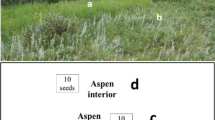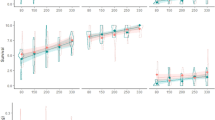Abstract
The positive effect of disturbance on plant community invasibility is one of the more consistent results in invasion ecology. It is generally attributed to a coincident increase in available resources (due to the disturbance) that allows non-resident plant species to establish (Davis MA, Grime JP Thompson K, J Ecol 88:528–534, 2000). However, most research addressing this issue has been in artificial or highly modified plant communities. Our goal in this study was to investigate the interactive effects of resource availability and plant mortality disturbance on the invasion of natural plant communities. We conducted a series of experiments that examined the response of Bromus tectorum L., a highly invasive annual grass, to experimentally created gradients of resource availability [nitrogen (N) and water] and resident plant species mortality. We found that B. tectorum biomass was co-limited by N and water. Biomass at the end of the growing season was a saturating function (i.e., increased to a maximum) of water, which determined maximum biomass, and N, which determined the rate at which maximum biomass was attained. Despite that fact that plant mortality increased N availability, it had a negative impact on invasion success. Plant mortality also decreased foliar cover, standing dead biomass, and soil cover by litter. In harsh environments, removing foliar and soil cover may increase germination and seedling stress by increasing soil temperatures and water loss. Across all treatments, B. tectorum success decreased with decreasing foliar cover and standing dead biomass. This, in combination with the strong limitation of B. tectorum biomass by water in this experiment, suggests that our plant mortality disturbance removed soil cover that may have otherwise aided B. tectorum invasion into this semi-arid plant community by reducing water stress.






Similar content being viewed by others
References
Adair EC (2005) Causes and Consequences of Exotic Species Invasion in the Ponderosa Pine Forests of Colorado’s Front Range. PhD Dissertation, Colorado State University, Fort Collins, Colorado
Baron JS, Reuth HM, Wolfe AM, Nydick KR, Allstott EJ, Minear JT, Moraska B (2000) Ecosystem responses to nitrogen deposition in the Colorado Front Range. Ecosystems 3:352–368
Beckstead J, Augspurger CK (2004) An experimental test of resistance to cheatgrass invasion: limiting resources at different life stages. Biol Invasions 6:417–432
Bertness MD, Callaway R (1994) Positive interactions in communities. Trends Ecol Evol 9:191–193
Bradford JB, Lauenroth WK (2006) Controls over invasion of Bromus tectorum: the importance of climate, soil, disturbance and seed availability. J Veg Sci 17:693–704
Brown CS, Rowe HI (2004) The unwelcome arrival of Bromus tectorum to high elevations. Proceedings of the High Altitude Revegetation Workshop. March 3–5, 2004, Fort Collins, Colorado
Burke MJW, Grime JP (1996) An experimental study of plant community invasibility. Ecology 77:776–790
Burnham KP, Anderson DR (2002) Model selection and multimodel inference: a practical information-theoretic approach, , 2nd edn. Springer-Verlag, New York
Chambers JC, Roundy BA, Blank RR, Meyer SE, Whittaker A (2007) What makes the Great Basin sagebrush ecosystems invasible by Bromus tectorum. Ecol Monogr 77:117–145
Chapin FS, Vitousek PM, VanCleve K (1986) The nature of nutrient limitation in plant communities. Am Nat 127:48–58
Chase TN, Pilke RA Sr, Kittel TGF, Baron JS, Stohlgren TJ (1999) Potential impacts on Colorado Rocky Mountain weather due to land use changes on the adjacent Great Plains. J Geophys Res 104(D14):16,673–16,690
Cornish PS, Burgin S (2005) Residual effects of glyphosate herbicide in ecological restoration. Restor Ecol 13:695–702
Coupland D, Caseley JC (1979) Presence of 14C activity in root exudates and guttation fluid from Agropyron repens treated with 14C-labelled glyphosate. New Phytol 83:17–22
Coupland D, Lutman PJ (1982) Investigations into the movement of glyphosate from treated to adjacent untreated plants. Ann Appl Biol 101:315–321
D’Antonio CM, Vitousek PM (1992) Biological invasions by exotic grasses, the grass/fire cycle, and global change. Annu Rev Ecol Syst 23:63–87
Davis MA, Grime JP, Thompson K (2000) Fluctuating resources in plant communities: a general theory of invasibility. J Ecol 88:528–534
Elliot ET (1986) Aggregate structure and carbon, nitrogen, and phosphorus in native and cultivated soils. Soil Sci Soc Am J 50:627–633
Evans RR, Dexter AG (2006) Late season redroot pigweed control in sugarbeet with over-the-top glyphosate. J Sugar Beet Res 43:35–46
Fenn ME, Haeuber R, Tonnesen GS, Baron JS, Grossman-Clarke S, Hope D, Jaffe DA, Copeland S, Geiser L, Rueth HM, Sickman JO (2003) Nitrogen emissions, deposition, and monitoring in the western United States. BioScience 53:391–403
Foster BL, Dickson TL (2004) Grassland diversity and productivity: the interplay of resource availability and propagule pools. Ecology 85:1541–1547
Fowler NL (1986) Microsite requirements for germination and establishment of three grass species. Am Midl Nat 115:131–145
Goldberg D, Novoplansky A (1997) On the relative importance of competition in unproductive environments. J Ecol 85:409–418
Greenlee JT, Callaway RM (1996) Abiotic stress and the relative importance of interference and facilitation in montane bunchgrass communities in western Montana. Am Nat 148:386–396
Holmgren M, Scheffer M, Huston MA (1997) The interplay of facilitation and competition in plant communities. Ecol 78:1966–1975
Huston MA (2004) Management strategies for plant invasions: manipulating productivity, disturbance and competition. Divers Distrib 10:167–178
Jackson LE, Calderon FJ, Steenwerth KL, Scow KM, Rolston DE (2003) Responses of soil microbial processes and community structure to tillage events and implications for soil quality. Geoderma 114:305–317
Kay BD (1990) Rates of changes of soil structure under different crop** systems. In: Stewart BA (ed) Advances in soil science. Springer-Verlag, New York, pp 1–52
Kitzberger T, Steinaker DF, Veblen TT (2000) Effects of climatic variability on facilitation of tree establishment in northern Patagonia. Ecology 81:1914–1924
Knapp PA (1996) Cheatgrass (Bromus tectorum L.) dominance in the Great Basin Desert. Global Environ Change 6:37–52
Kristensen HL, McCarty GW, Meisinger JJ (2000) Effects of soil structure disturbance on mineralization of organic soil nitrogen. Soil Sci Soc Am J 64:371–378
Levin JM, D’Antonio CM (1999) Elton revisited: a review of evidence liking diversity and invasibility. Oikos 87:15–26
Link SO, Bolton H, Thiede ME, Rickard WH (1995) Responses of downy brome to nitrogen and water. J Range Manag 48:290–297
Lonsdale WM (1999) Global patterns of plant invasions and the concept of invasibility. Ecology 80:1522–1536
Lowe PN, Lauenroth WK, Burke IC (2003) Effects of nitrogen availability on competition between Bromus tectorum and Bouteloua gracilis. Plant Ecol 167:247–254
Mack RN (1981) Invasion of Bromus tectorum L. into western North America: An ecological chronicle. Agro-Ecosystems 7:145–165
Mack RN (1986) Alien plant invasion into the Intermountain West: a case history. In: Mooney HA, Drake JA (eds) Ecology of biological invasions of North America and Hawaii. New York, Springer-Verlag. Ecol Stud 58:191–213
Mack RN, Simberloff D, Lonsdale WM, Evans H, Clout M, Bazzaz FA (2000) Biotic invasions: causes, epidemiology, global consequences, and control. Ecol Appl 10:689–710
Monaco TA, Johnson DA, Norton JM, Jones TA, Connors KJ, Norton JB, Redinbaugh MB (2003) Contrasting responses of Intermountain West grasses to soil nitrogen. J Range Manag 56:282–290
National Climatic Data Center (NCDC) (2005) Daily and monthly surface data for: Buckhorn Mountain 1e, Larimer County, Colorado, station ID 051060; Fort Collins 4 E, Larimer County, Colorado, station ID 053006; Fort Collins, Larimer County, Colorado, station ID 053005; Flatiron 8 WSW, station ID 052934; Loveland NCWCD, Larimer County, Colorado, station ID 055236; Virginia Dale 7 ENE, Larimer County, Colorado, station ID 058690; Waterdale, Larimer County, Colorado, station ID 058839; and Wellington 5 WNW, Larimer County, Colorado, station ID 058907. http://www4.ncdc.noaa.gov/cgi-win/wwcgi.dll?wwDI~StnSrch~StnID~20003975#DAF
National Park Service (NPS) (2000) 1999 Annual Fire Report on Research, Monitoring, and Inventory for Sequioa and Kings Canyon National Park. http://www.nps.gov/seki/fire/afr_99/contents.htm
Norton JB, Monaco TA, Norton JM, Johnson DA, Jones TA (2003) Cheatgrass invasion alters soil morphology and organic matter dynamics in big sagebrush steppe rangelands. USDA Forest Service Proceedings, RRS-P-31.2004: 57–63
Norton JB, Monaco TA, Norton JM, Johnson DA, Jones TA (2004) Soil morphology and organic matter dynamics under cheatgrass and sagebrush-steppe plant communities. J Arid Envt 57:445–466
Norton JB, Monaco TA, Norton U (2007) Mediterranean annual grasses in western North America: kids in a candy store. Plant Soil 298:1–5
Novak SJ, Mack RN (2001) Tracing plant introduction and spread: Genetic evidence from Bromus tectorum (Cheatgrass). Biosci 51:114–122
Novak SJ, Mack RN, Soltis DE (1991) Genetic variation in Bromus tectorum (Poaceae): population differentiation in its North American range. Am J Bot 78:1150–1161
Peters EF, Bunting SC (1994) Fire conditions and pre- and post-occurrence of annual grasses on the Snake River plain. In: Monsen SB, Kitchen SG (ed) Proceedings-Ecology and management of annual rangelands. USDA Forest Service INT-GTR-313
Rice KJ, Mack RN (1991a) The ecological genetics of Bromus tectorum I. A hierarchical analysis of phenotypic variation. Oecologia 88:77–83
Rice KJ, Mack RN (1991b) The ecological genetics of Bromus tectorum III. The demography of reciprocally sown populations. Oecologia 88:91–101
Rickard WH, Vaughan BE (1988) Plant communities, characteristics and responses. In: Rickard WH, Rogers LE, Vaughan BE, Liebetrau SF (eds) Shrub-Steppe: Balance and change in a semi-arid terrestrial ecosystem. Elsevier, Amsterdam, NL
Rodrigues JJV, Worsham AD, Corbin FT (1982) Exudation of glyphosate from wheat (Triticum aestivum) plants and its effects on interplanted corn (Zea mays) and soybeans (Glycine max). Weed Sci 30:316–320
Soil Survey Staff, Natural Resources Conservation Service, United States Department of Agriculture (2007) Web Soil Survey. http://websoilsurvey.nrcs.usda.gov/
Stewart G, Hull AC (1949) Cheatgrass (Bromus tectorum L.) – an ecologic intruder in southern Idaho. Ecology 30:58–74
Stohlgren TJ, Chase TN, Pielke RA Sr, Kittel TGF, Baron J (1998) Evidence that local land use practices influence regional climate, vegetation, and stream flow patterns in adjacent natural areas. Glob Chang Biol 4:495–504
Stohlgren TJ, Otsuki Y, Villa CA, Lee M, Belnap J (2001) Patterns of plant invasions: a case example in native species hotspots and rare habitats. Biol Invasions 00:1–14
Thompson K, Hodgson JG, Grime JP, Burke MJ (2001) Plant traits and temporal scale: evidence from a five year invasion experiment using native species. J Ecol 89:1054–1060
West NE (1979) Basic synecological relationships of sagebrush-dominated lands in the Great Basin and Colorado Plateau. The Sagebrush Ecosystem: a Symposium. Salt Lake City, Utah State University: 33–41
Western Regional Climate Center (2006) Colorado Climate Summaries. Fort Collins (Station ID: 053005) and Buckhorn Mt 1 E (Station ID 051060) stations, http://www.wrcc.dri.edu/summary/climsmco.html
Whisenant SG (1990) Changing fire frequencies on Idaho’s Snake River Plains: ecological and management implications. In: McArthur ED, EM Romney, SD Smith and PT Tueller (eds) Proceedings – Symposium on Cheatgrass Invasion, Shrub Die-off, and Other Aspects of Shrub Biology and Management. Intermountain Research Station, Forest Service, U.S. Department of Agriculture, Ogden, Utah, pp 4–10
Acknowledgements
Sonia Hall, John Bradford, Drew Ditter, and Moises Soto all provided invaluable assistance with the installation and maintenance of this experiment. S. Hall, J. Bradford, J. B. Norton, M. A. Huston, and anonymous reviewers provided extremely helpful comments and critiques. Many thanks to the US Forest Service for allowing us to utilize National Forest land for site locations. Funding for this research came from the McIntyre-Stennis Program.
Author information
Authors and Affiliations
Corresponding author
Additional information
Responsible Editor: Tibor Kalapos.
Rights and permissions
About this article
Cite this article
Adair, E.C., Burke, I.C. & Lauenroth, W.K. Contrasting effects of resource availability and plant mortality on plant community invasion by Bromus tectorum L.. Plant Soil 304, 103–115 (2008). https://doi.org/10.1007/s11104-007-9525-9
Received:
Accepted:
Published:
Issue Date:
DOI: https://doi.org/10.1007/s11104-007-9525-9




